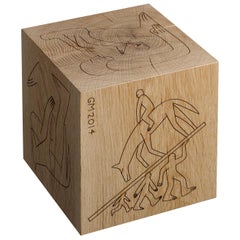Geoff Mcfetridge
21st Century and Contemporary German Modern Tables
Oak
Recent Sales
21st Century and Contemporary German Modern Tables
Oak
People Also Browsed
21st Century and Contemporary German Modern Dining Room Tables
Wood
21st Century and Contemporary German Modern Tables
Wood
21st Century and Contemporary German Modern Dining Room Tables
Wood
e15 for sale on 1stDibs
While renowned furniture company e15 was named for the London postcode district where it opened its first workshop in 1995, the now Frankfurt-based brand has grown to become one of the most celebrated German manufacturers and a premium option for modern, solid-wood furniture across much of Europe.
In 1995, German-born architect and designer Philipp Mainzer founded e15 with Farah Ebrahimi, who currently serves as the company’s head designer and art director. After majoring in product design at Central Saint Martins College of Art and Design and architecture at the Architectural Association, Mainzer had what he has called “a gut feeling” to produce wooden furniture to counter the cold aluminum and glass structures that were popular at the time. E15 became a vessel for Mainzer to explore contemporary design with a somewhat minimalist profile and to highlight the natural characteristics of quality materials, especially oak, as seen in Mainzer’s Backenzahn stool.
Setting e15 apart is its unrelenting passion for sustainability. Many of e15’s talented collaborators pride themselves on this philosophy, including British architect David Chipperfield, German industrial designer Stefan Diez and Danish architect and interior designer David Thulstrup.
Many of the company’s designs have earned awards and have been exhibited extensively in Germany, such as Chipperfield’s Leighton coffee table at the 2016 IMM Cologne furniture show. Mainzer and Ebrahimi won two prizes for separate modular sofas: the SHIRAZ sofa received the 2008 Design Award of the Federal Republic of Germany and the KERMAN took home the gold for Interior Innovation in 2017. Select e15 pieces can also be found in museum collections worldwide.
On 1stDibs, find e15 tables, seating and storage case pieces.
A Close Look at Modern Furniture
The late 19th and early 20th centuries saw sweeping social change and major scientific advances — both of which contributed to a new aesthetic: modernism. Rejecting the rigidity of Victorian artistic conventions, modernists sought a new means of expression. References to the natural world and ornate classical embellishments gave way to the sleek simplicity of the Machine Age. Architect Philip Johnson characterized the hallmarks of modernism as “machine-like simplicity, smoothness or surface [and] avoidance of ornament.”
Early practitioners of modernist design include the De Stijl (“The Style”) group, founded in the Netherlands in 1917, and the Bauhaus School, founded two years later in Germany.
Followers of both groups produced sleek, spare designs — many of which became icons of daily life in the 20th century. The modernists rejected both natural and historical references and relied primarily on industrial materials such as metal, glass, plywood, and, later, plastics. While Bauhaus principals Marcel Breuer and Ludwig Mies van der Rohe created furniture from mass-produced, chrome-plated steel, American visionaries like Charles and Ray Eames worked in materials as novel as molded plywood and fiberglass. Today, Breuer’s Wassily chair, Mies van der Rohe’s Barcelona chair — crafted with his romantic partner, designer Lilly Reich — and the Eames lounge chair are emblems of progressive design and vintage originals are prized cornerstones of collections.
It’s difficult to overstate the influence that modernism continues to wield over designers and architects — and equally difficult to overstate how revolutionary it was when it first appeared a century ago. But because modernist furniture designs are so simple, they can blend in seamlessly with just about any type of décor. Don’t overlook them.
Finding the Right Tables for You
The right vintage, new or antique tables can help make any space in your home stand out.
Over the years, the variety of tables available to us, as well as our specific needs for said tables, has broadened. Today, with all manner of these must-have furnishings differing in shape, material and style, any dining room table can shine just as brightly as the guests who gather around it.
Remember, when shopping for a dining table, it must fit your dining area, and you need to account for space around the table too — think outside the box, as an oval dining table may work for tighter spaces. Alternatively, if you’ve got the room, a Regency-style dining table can elevate any formal occasion at mealtime.
Innovative furniture makers and designers have also redefined what a table can be. Whether it’s an unconventional Ping-Pong table, a brass side table to display your treasured collectibles or a Louis Vuitton steamer trunk to add an air of nostalgia to your loft, your table can say a lot about you.
The visionary work of French designer Xavier Lavergne, for example, includes tables that draw on the forms of celestial bodies as often as they do aquatic creatures or fossils. Elsewhere, Italian architect Gae Aulenti, who looked to Roman architecture in crafting her stately Jumbo coffee table, created clever glass-topped mobile coffee tables that move on bicycle tires or sculpted wood wheels for Fontana Arte.
Coffee and cocktail tables can serve as a room’s centerpiece with attention-grabbing details and colors. Glass varieties will keep your hardwood flooring and dazzling area rugs on display, while a marble or stone coffee table in a modern interior can showcase your prized art books and decorative objects. A unique vintage desk or writing table can bring sophistication and even a bit of spice to your work life.
No matter your desired form or function, a quality table for your living space is a sound investment. On 1stDibs, browse a collection of vintage, new and antique bedside tables, mid-century end tables and more .






